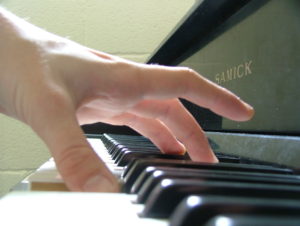The Half-Diminished Seventh Chord – How It Is Used On The Piano
Half-Diminished Seventh Chord – What Is It Good For?
In music theory, the half–diminished seventh chord—also known as a half-diminished chord or a minor seventh flat five (m7â™5)—is formed by a root note, a minor third, a diminished fifth, and a minor seventh. Its consecutive intervals are minor 3rd, minor 3rd, major 3rd.
Good morning. This is Duane and today I’d like to talk about the half-diminished 7th chord. You know what a 7th chord is, it’s a chord that’s built out of a triad plus the 7th note of the scale, 1, 2, 3, 4, 5, 6, 7. There’s 2 kinds of 7ths. There’s a Major 7th and there’s a dominant 7th. Well, this half-diminished 7th is a diminished triad. In other words, you lower the 3rd and the 5th a half-step, so it’s a root flat 3rd flat 5th, and a flat 7th. That’s why it’s called half-diminished.
A full-diminished would be a whole step down from the 7th. This is a diminished 7th, as you know, that uses a whole step, a double-flat on the 7th, but this is only a flat 7th, so that’s the chord you have. Now it’s not a very much used chord but it’s a beautiful chord at the same time. It’s really like playing E flat minor 7th over C. I kind of like that feeling, it’s a nice, nice feeling to it, particularly if you just go up a 4th, for example. That’s a C 7th of sorts going to an F 7th, very nice.
I just want to show you something. Let’s come down a half a step from that C diminished half-diminished 7th, move down almost down a half-step and what do you have? You’ve got B half-diminished 7th, don’t you? Here’s B Major, so you lower the 3rd, you lower the 5th, and you lower the 7th a half-step. The 4 notes are all white, is my point here, which makes it easy then to do something like that, to make a run.
I’ll give you an example. Let me play “Summertime” because it has that chord in it, and there’s a lot of songs that would come to B diminished 7th, but let me play that. I’ll play real slow so you can get the idea. Now this is a half-diminished 7th. Now when you get there, you have a chance to take that chord, I would invert it to make it a little easier to run, so I play F, A, B, D, F, A, B, D, F, A, B, D. Then you’ve got plenty of time if you want to, to come back down to the next chord before you go on. Now I’ll do it context.
Notice I think I have time to go up 3 times, 1, 2, 3, yeah, 1, 2, 3, before I ran out of time to continue. That’s a nice way to make a rapid-fire run if you want to. Of course, you don’t have it 3 times, you can do it once and go all the way up if you wanted to, and then go on. There’s just an idea you can use in your piano playing anytime you run into a half-diminished 7th.
That’s it for today. We’ll see you tomorrow with another short little video like this. I hope to see you there. Bye-bye for now.
Click on this link to watch this video on YouTube: https://www.youtube.com/watch?v=2pWQF-yp-PQ&feature=youtu.be
***For lots more good stuff on piano playing come on over to my website at https://www.playpiano.com and sign up for our free piano tips – “Exciting Piano Chords & Sizzling Chord Progressions!”
Here’s a great little book on chords and chord progressions on Amazon: http://www.amazon.com/Piano-Chords-Chord-Progressions-Exciting-ebook/dp/B0076OUGDE/ref=sr_1_1?s=books&ie=UTF8&qid=1404158669&sr=1-1&keywords=piano+chords+duane+shinn
ÂÂÂÂÂÂÂÂÂÂÂÂÂÂÂÂÂÂÂÂÂÂÂÂÂÂÂÂÂÂÂÂÂÂ____________________________________________________________________________________



